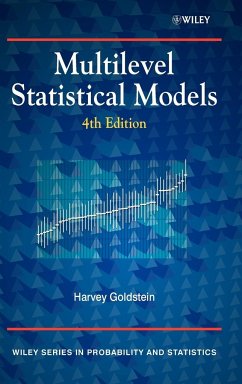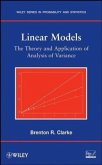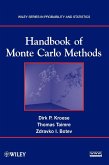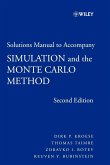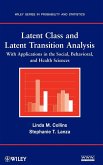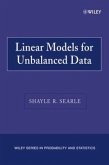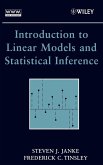Harvey Goldstein
Multilevel Statistical Models 4e
Harvey Goldstein
Multilevel Statistical Models 4e
- Gebundenes Buch
- Merkliste
- Auf die Merkliste
- Bewerten Bewerten
- Teilen
- Produkt teilen
- Produkterinnerung
- Produkterinnerung
Throughout the social, medical and other sciences the importance of understanding complex hierarchical data structures is well understood. Multilevel modelling is now the accepted statistical technique for handling such data and is widely available in computer software packages. A thorough understanding of these techniques is therefore important for all those working in these areas. This new edition of Multilevel Statistical Models brings these techniques together, starting from basic ideas and illustrating how more complex models are derived. Bayesian methodology using MCMC has been extended…mehr
Andere Kunden interessierten sich auch für
![Linear Models Linear Models]() Brenton R. ClarkeLinear Models140,99 €
Brenton R. ClarkeLinear Models140,99 €![MCM Handbook MCM Handbook]() Dirk P. KroeseMCM Handbook170,99 €
Dirk P. KroeseMCM Handbook170,99 €![Student Solutions Manual to Accompany Simulation and the Monte Carlo Method Student Solutions Manual to Accompany Simulation and the Monte Carlo Method]() Dirk P. KroeseStudent Solutions Manual to Accompany Simulation and the Monte Carlo Method39,99 €
Dirk P. KroeseStudent Solutions Manual to Accompany Simulation and the Monte Carlo Method39,99 €![Latent Class Analysis Latent Class Analysis]() Linda M. CollinsLatent Class Analysis131,99 €
Linda M. CollinsLatent Class Analysis131,99 €![Linear Models for Unbalanced Data Linear Models for Unbalanced Data]() Shayle R. SearleLinear Models for Unbalanced Data150,99 €
Shayle R. SearleLinear Models for Unbalanced Data150,99 €![Linear Models Linear Models]() Steven J. JankeLinear Models172,99 €
Steven J. JankeLinear Models172,99 €![Extreme Value and Related Models Extreme Value and Related Models]() Narayanaswamy BalakrishnanExtreme Value and Related Models171,99 €
Narayanaswamy BalakrishnanExtreme Value and Related Models171,99 €-
-
-
Throughout the social, medical and other sciences the importance of understanding complex hierarchical data structures is well understood. Multilevel modelling is now the accepted statistical technique for handling such data and is widely available in computer software packages. A thorough understanding of these techniques is therefore important for all those working in these areas. This new edition of Multilevel Statistical Models brings these techniques together, starting from basic ideas and illustrating how more complex models are derived. Bayesian methodology using MCMC has been extended along with new material on smoothing models, multivariate responses, missing data, latent normal transformations for discrete responses, structural equation modeling and survival models.
Key Features:
Provides a clear introduction and a comprehensive account of the
of multilevel models.
New methodological developments and applications are explored.
Written by a leading expert in the field of multilevel methodology.
Illustrated throughout with real-life examples, explaining theoretical
concepts.
This book is suitable as a comprehensive text for postgraduate courses, as well as a general reference guide. Applied statisticians in the social sciences, economics, biological and medical disciplines will find this book beneficial.
Key Features:
Provides a clear introduction and a comprehensive account of the
of multilevel models.
New methodological developments and applications are explored.
Written by a leading expert in the field of multilevel methodology.
Illustrated throughout with real-life examples, explaining theoretical
concepts.
This book is suitable as a comprehensive text for postgraduate courses, as well as a general reference guide. Applied statisticians in the social sciences, economics, biological and medical disciplines will find this book beneficial.
Produktdetails
- Produktdetails
- Wiley Series in Probability and Statistics
- Verlag: Wiley & Sons
- 4. Aufl.
- Seitenzahl: 384
- Erscheinungstermin: 3. November 2010
- Englisch
- Abmessung: 235mm x 157mm x 25mm
- Gewicht: 688g
- ISBN-13: 9780470748657
- ISBN-10: 0470748656
- Artikelnr.: 31187218
- Herstellerkennzeichnung
- Libri GmbH
- Europaallee 1
- 36244 Bad Hersfeld
- gpsr@libri.de
- Wiley Series in Probability and Statistics
- Verlag: Wiley & Sons
- 4. Aufl.
- Seitenzahl: 384
- Erscheinungstermin: 3. November 2010
- Englisch
- Abmessung: 235mm x 157mm x 25mm
- Gewicht: 688g
- ISBN-13: 9780470748657
- ISBN-10: 0470748656
- Artikelnr.: 31187218
- Herstellerkennzeichnung
- Libri GmbH
- Europaallee 1
- 36244 Bad Hersfeld
- gpsr@libri.de
From the Boston area, Nichol is a fan of all things art. Known for her weirdness, and general snarkasm, Nichol works to engage her audience in several mediums. Many stick to one favorite genre, but she can't seem to make up her mind. You will see her dipping into everything from graphic horror, graphic novels, to graphic romance. Trust the descriptions, mind the tags and just know that, if you like her writing, you're in for a good ride. Her favorite colors are black and burgundy red, and she loves tea with honey, indulging once a week on Saturday. Specifically Saturday. If it's not Saturday, tea shall not happen.
Contents
Dedication
Preface
Acknowledgements
Notation
A general classification notation and diagram
Glossary
Chapter 1 An introduction to multilevel models
1.1 Hierarchically structured data
1.2 School effectiveness
1.3 Sample survey methods
1.4 Repeated measures data
1.5 Event history and survival models
1.6 Discrete response data
1.7 Multivariate models
1.8 Nonlinear models
1.9 Measurement errors
1.10 Cross classifications and multiple membership structures.
1.11 Factor analysis and structural equation models
1.12 Levels of aggregation and ecological fallacies
1.13 Causality
1.14 The latent normal transformation and missing data
1.15 Other texts
1.16 A caveat
Chapter 2 The 2-level model
2.1 Introduction
2.2 The 2-level model
2.3 Parameter estimation
2.4 Maximum likelihood estimation using Iterative Generalised Least Squares
(IGLS)
2.5 Marginal models and Generalized Estimating Equations (GEE)
2.6 Residuals
2.7 The adequacy of Ordinary Least Squares estimates.
2.8 A 2-level example using longitudinal educational achievement data
2.9 General model diagnostics
2.10 Higher level explanatory variables and compositional effects
2.11 Transforming to normality
2.12 Hypothesis testing and confidence intervals
2.13 Bayesian estimation using Markov Chain Monte Carlo (MCMC)
2.14 Data augmentation
Appendix 2.1 The general structure and maximum likelihood estimation for a
multilevel model
Appendix 2.2 Multilevel residuals estimation
Appendix 2.3 Estimation using profile and extended likelihood
Appendix 2.4 The EM algorithm
Appendix 2.5 MCMC sampling
Chapter 3. Three level models and more complex hierarchical structures.
3.1 Complex variance structures
3.2 A 3-level complex variation model example.
3.3 Parameter Constraints
3.4 Weighting units
3.5 Robust (Sandwich) Estimators and Jacknifing
3.6 The bootstrap
3.7 Aggregate level analyses
3.8 Meta analysis
3.9 Design issues
Chapter 4. Multilevel Models for discrete response data
4.1 Generalised linear models
4.2 Proportions as responses
4.3 Examples
4.4 Models for multiple response categories
4.5 Models for counts
4.6 Mixed discrete - continuous response models
4.7 A latent normal model for binary responses
4.8 Partitioning variation in discrete response models
Appendix 4.1. Generalised linear model estimation
Appendix 4.2 Maximum likelihood estimation for generalised linear models
Appendix 4.3 MCMC estimation for generalised linear models
Appendix 4.4. Bootstrap estimation for generalised linear models
Chapter 5. Models for repeated measures data
5.1 Repeated measures data
5.2 A 2-level repeated measures model
5.3 A polynomial model example for adolescent growth and the prediction of
adult height
5.4 Modelling an autocorrelation structure at level 1.
5.5 A growth model with autocorrelated residuals
5.6 Multivariate repeated measures models
5.7 Scaling across time
5.8 Cross-over designs
5.9 Missing data
5.10 Longitudinal discrete response data
Chapter 6. Multivariate multilevel data
6.1 Introduction
6.2 The basic 2-level multivariate model
6.3 Rotation Designs
6.4 A rotation design example using Science test scores
6.5 Informative response selection: subject choice in examinations
6.6 Multivariate structures at higher levels and future predictions
6.7 Multivariate responses at several levels
6.8 Principal Components analysis
Appendix 6.1 MCMC algorithm for a multivariate normal response model with
constraints
Chapter 7. Latent normal models for multivariate data
7.1 The normal multilevel multivariate model
7.2 Sampling binary responses
7.3 Sampling ordered categorical responses
7.4 Sampling unordered categorical responses
7.5 Sampling count data
7.6 Sampling continuous non-normal data
7.7 Sampling the level 1 and level 2 covariance matrices
7.8 Model fit
7.9 Partially ordered data
7.10 Hybrid normal/ordered variables
7.11 Discussion
Chapter 8. Multilevel factor analysis, structural equation and mixture
models
8.1 A 2-stage 2-level factor model
8.2 A general multilevel factor model
8.3 MCMC estimation for the factor model
8.4 Structural equation models
8.5 Discrete response multilevel structural equation models
8.6 More complex hierarchical latent variable models
8.7 Multilevel mixture models
Chapter 9. Nonlinear multilevel models
9.1 Introduction
9.2 Nonlinear functions of linear components
9.3 Estimating population means
9.4 Nonlinear functions for variances and covariances
9.5 Examples of nonlinear growth and nonlinear level 1 variance
Appendix 9.1 Nonlinear model estimation
Chapter 10. Multilevel modelling in sample surveys
10.1 Sample survey structures
10.2 Population structures
10.3 Small area estimation
Chapter 11 Multilevel event history and survival models
11.1 Introduction
11.2 Censoring
11.3 Hazard and survival funtions
11.4 Parametric proportional hazard models
11.5 The semiparametric Cox model
11.6 Tied observations
11.7 Repeated events proportional hazard models
11.8 Example using birth interval data
11.9 Log duration models
11.10 Examples with birth interval data and children's activity episodes
11.11 The grouped discrete time hazards model
11.12 Discrete time latent normal event history models
Chapter 12. Cross classified data structures
12.1 Random cross classifications
12.2 A basic cross classified model
12.3 Examination results for a cross classification of schools
12.4 Interactions in cross classifications
12.5 Cross classifications with one unit per cell
12.6 Multivariate cross classified models
12.7 A general notation for cross classifications
12.8 MCMC estimation in cross classified models
Appendix 12.1 IGLS Estimation for cross classified data.
Chapter 13 Multiple membership models
13.1 Multiple membership structures
13.2 Notation and classifications for multiple membership structures
13.3 An example of salmonella infection
13.4 A repeated measures multiple membership model
13.5 Individuals as higher level units
13.5.1 Example of research grant awards
13.6 Spatial models
13.7 Missing identification models
Appendix 13.1 MCMC estimation for multiple membership models.
Chapter 14 Measurement errors in multilevel models
14.1 A basic measurement error model
14.2 Moment based estimators
14.3 A 2-level example with measurement error at both levels.
14.4 Multivariate responses
14.5 Nonlinear models
14.6 Measurement errors for discrete explanatory variables
14.7 MCMC estimation for measurement error models
Appendix 14.1 Measurement error estimation
14.2 MCMC estimation for measurement error models
Chapter 15. Smoothing models for multilevel data.
15.1 Introduction
15.2. Smoothing estimators
15.3 Smoothing splines
15.4 Semi parametric smoothing models
15.5 Multilevel smoothing models
15.6 General multilevel semi-parametric smoothing models
15.7 Generalised linear models
15.8 An example
Fixed
Random
15.9 Conclusions
Chapter 16. Missing data, partially observed data and multiple imputation
16.1 Creating a completed data set
16.2 Joint modelling for missing data
16.3 A two level model with responses of different types at both levels.
16.4 Multiple imputation
16.5 A simulation example of multiple imputation for missing data
16.6 Longitudinal data with attrition
16.7 Partially known data values
16.8 Conclusions
Chapter 17 Multilevel models with correlated random effects
17.1 Non-independence of level 2 residuals
17.2 MCMC estimation for non-independent level 2 residuals
17.3 Adaptive proposal distributions in MCMC estimation
17.4 MCMC estimation for non-independent level 1 residuals
17.5 Modelling the level 1 variance as a function of explanatory variables
with random effects
17.6 Discrete responses with correlated random effects
17.7 Calculating the DIC statistic
17.8 A growth data set
17.9 Conclusions
Chapter 18. Software for multilevel modelling
References
Author index
Subject index
Dedication
Preface
Acknowledgements
Notation
A general classification notation and diagram
Glossary
Chapter 1 An introduction to multilevel models
1.1 Hierarchically structured data
1.2 School effectiveness
1.3 Sample survey methods
1.4 Repeated measures data
1.5 Event history and survival models
1.6 Discrete response data
1.7 Multivariate models
1.8 Nonlinear models
1.9 Measurement errors
1.10 Cross classifications and multiple membership structures.
1.11 Factor analysis and structural equation models
1.12 Levels of aggregation and ecological fallacies
1.13 Causality
1.14 The latent normal transformation and missing data
1.15 Other texts
1.16 A caveat
Chapter 2 The 2-level model
2.1 Introduction
2.2 The 2-level model
2.3 Parameter estimation
2.4 Maximum likelihood estimation using Iterative Generalised Least Squares
(IGLS)
2.5 Marginal models and Generalized Estimating Equations (GEE)
2.6 Residuals
2.7 The adequacy of Ordinary Least Squares estimates.
2.8 A 2-level example using longitudinal educational achievement data
2.9 General model diagnostics
2.10 Higher level explanatory variables and compositional effects
2.11 Transforming to normality
2.12 Hypothesis testing and confidence intervals
2.13 Bayesian estimation using Markov Chain Monte Carlo (MCMC)
2.14 Data augmentation
Appendix 2.1 The general structure and maximum likelihood estimation for a
multilevel model
Appendix 2.2 Multilevel residuals estimation
Appendix 2.3 Estimation using profile and extended likelihood
Appendix 2.4 The EM algorithm
Appendix 2.5 MCMC sampling
Chapter 3. Three level models and more complex hierarchical structures.
3.1 Complex variance structures
3.2 A 3-level complex variation model example.
3.3 Parameter Constraints
3.4 Weighting units
3.5 Robust (Sandwich) Estimators and Jacknifing
3.6 The bootstrap
3.7 Aggregate level analyses
3.8 Meta analysis
3.9 Design issues
Chapter 4. Multilevel Models for discrete response data
4.1 Generalised linear models
4.2 Proportions as responses
4.3 Examples
4.4 Models for multiple response categories
4.5 Models for counts
4.6 Mixed discrete - continuous response models
4.7 A latent normal model for binary responses
4.8 Partitioning variation in discrete response models
Appendix 4.1. Generalised linear model estimation
Appendix 4.2 Maximum likelihood estimation for generalised linear models
Appendix 4.3 MCMC estimation for generalised linear models
Appendix 4.4. Bootstrap estimation for generalised linear models
Chapter 5. Models for repeated measures data
5.1 Repeated measures data
5.2 A 2-level repeated measures model
5.3 A polynomial model example for adolescent growth and the prediction of
adult height
5.4 Modelling an autocorrelation structure at level 1.
5.5 A growth model with autocorrelated residuals
5.6 Multivariate repeated measures models
5.7 Scaling across time
5.8 Cross-over designs
5.9 Missing data
5.10 Longitudinal discrete response data
Chapter 6. Multivariate multilevel data
6.1 Introduction
6.2 The basic 2-level multivariate model
6.3 Rotation Designs
6.4 A rotation design example using Science test scores
6.5 Informative response selection: subject choice in examinations
6.6 Multivariate structures at higher levels and future predictions
6.7 Multivariate responses at several levels
6.8 Principal Components analysis
Appendix 6.1 MCMC algorithm for a multivariate normal response model with
constraints
Chapter 7. Latent normal models for multivariate data
7.1 The normal multilevel multivariate model
7.2 Sampling binary responses
7.3 Sampling ordered categorical responses
7.4 Sampling unordered categorical responses
7.5 Sampling count data
7.6 Sampling continuous non-normal data
7.7 Sampling the level 1 and level 2 covariance matrices
7.8 Model fit
7.9 Partially ordered data
7.10 Hybrid normal/ordered variables
7.11 Discussion
Chapter 8. Multilevel factor analysis, structural equation and mixture
models
8.1 A 2-stage 2-level factor model
8.2 A general multilevel factor model
8.3 MCMC estimation for the factor model
8.4 Structural equation models
8.5 Discrete response multilevel structural equation models
8.6 More complex hierarchical latent variable models
8.7 Multilevel mixture models
Chapter 9. Nonlinear multilevel models
9.1 Introduction
9.2 Nonlinear functions of linear components
9.3 Estimating population means
9.4 Nonlinear functions for variances and covariances
9.5 Examples of nonlinear growth and nonlinear level 1 variance
Appendix 9.1 Nonlinear model estimation
Chapter 10. Multilevel modelling in sample surveys
10.1 Sample survey structures
10.2 Population structures
10.3 Small area estimation
Chapter 11 Multilevel event history and survival models
11.1 Introduction
11.2 Censoring
11.3 Hazard and survival funtions
11.4 Parametric proportional hazard models
11.5 The semiparametric Cox model
11.6 Tied observations
11.7 Repeated events proportional hazard models
11.8 Example using birth interval data
11.9 Log duration models
11.10 Examples with birth interval data and children's activity episodes
11.11 The grouped discrete time hazards model
11.12 Discrete time latent normal event history models
Chapter 12. Cross classified data structures
12.1 Random cross classifications
12.2 A basic cross classified model
12.3 Examination results for a cross classification of schools
12.4 Interactions in cross classifications
12.5 Cross classifications with one unit per cell
12.6 Multivariate cross classified models
12.7 A general notation for cross classifications
12.8 MCMC estimation in cross classified models
Appendix 12.1 IGLS Estimation for cross classified data.
Chapter 13 Multiple membership models
13.1 Multiple membership structures
13.2 Notation and classifications for multiple membership structures
13.3 An example of salmonella infection
13.4 A repeated measures multiple membership model
13.5 Individuals as higher level units
13.5.1 Example of research grant awards
13.6 Spatial models
13.7 Missing identification models
Appendix 13.1 MCMC estimation for multiple membership models.
Chapter 14 Measurement errors in multilevel models
14.1 A basic measurement error model
14.2 Moment based estimators
14.3 A 2-level example with measurement error at both levels.
14.4 Multivariate responses
14.5 Nonlinear models
14.6 Measurement errors for discrete explanatory variables
14.7 MCMC estimation for measurement error models
Appendix 14.1 Measurement error estimation
14.2 MCMC estimation for measurement error models
Chapter 15. Smoothing models for multilevel data.
15.1 Introduction
15.2. Smoothing estimators
15.3 Smoothing splines
15.4 Semi parametric smoothing models
15.5 Multilevel smoothing models
15.6 General multilevel semi-parametric smoothing models
15.7 Generalised linear models
15.8 An example
Fixed
Random
15.9 Conclusions
Chapter 16. Missing data, partially observed data and multiple imputation
16.1 Creating a completed data set
16.2 Joint modelling for missing data
16.3 A two level model with responses of different types at both levels.
16.4 Multiple imputation
16.5 A simulation example of multiple imputation for missing data
16.6 Longitudinal data with attrition
16.7 Partially known data values
16.8 Conclusions
Chapter 17 Multilevel models with correlated random effects
17.1 Non-independence of level 2 residuals
17.2 MCMC estimation for non-independent level 2 residuals
17.3 Adaptive proposal distributions in MCMC estimation
17.4 MCMC estimation for non-independent level 1 residuals
17.5 Modelling the level 1 variance as a function of explanatory variables
with random effects
17.6 Discrete responses with correlated random effects
17.7 Calculating the DIC statistic
17.8 A growth data set
17.9 Conclusions
Chapter 18. Software for multilevel modelling
References
Author index
Subject index
Contents
Dedication
Preface
Acknowledgements
Notation
A general classification notation and diagram
Glossary
Chapter 1 An introduction to multilevel models
1.1 Hierarchically structured data
1.2 School effectiveness
1.3 Sample survey methods
1.4 Repeated measures data
1.5 Event history and survival models
1.6 Discrete response data
1.7 Multivariate models
1.8 Nonlinear models
1.9 Measurement errors
1.10 Cross classifications and multiple membership structures.
1.11 Factor analysis and structural equation models
1.12 Levels of aggregation and ecological fallacies
1.13 Causality
1.14 The latent normal transformation and missing data
1.15 Other texts
1.16 A caveat
Chapter 2 The 2-level model
2.1 Introduction
2.2 The 2-level model
2.3 Parameter estimation
2.4 Maximum likelihood estimation using Iterative Generalised Least Squares
(IGLS)
2.5 Marginal models and Generalized Estimating Equations (GEE)
2.6 Residuals
2.7 The adequacy of Ordinary Least Squares estimates.
2.8 A 2-level example using longitudinal educational achievement data
2.9 General model diagnostics
2.10 Higher level explanatory variables and compositional effects
2.11 Transforming to normality
2.12 Hypothesis testing and confidence intervals
2.13 Bayesian estimation using Markov Chain Monte Carlo (MCMC)
2.14 Data augmentation
Appendix 2.1 The general structure and maximum likelihood estimation for a
multilevel model
Appendix 2.2 Multilevel residuals estimation
Appendix 2.3 Estimation using profile and extended likelihood
Appendix 2.4 The EM algorithm
Appendix 2.5 MCMC sampling
Chapter 3. Three level models and more complex hierarchical structures.
3.1 Complex variance structures
3.2 A 3-level complex variation model example.
3.3 Parameter Constraints
3.4 Weighting units
3.5 Robust (Sandwich) Estimators and Jacknifing
3.6 The bootstrap
3.7 Aggregate level analyses
3.8 Meta analysis
3.9 Design issues
Chapter 4. Multilevel Models for discrete response data
4.1 Generalised linear models
4.2 Proportions as responses
4.3 Examples
4.4 Models for multiple response categories
4.5 Models for counts
4.6 Mixed discrete - continuous response models
4.7 A latent normal model for binary responses
4.8 Partitioning variation in discrete response models
Appendix 4.1. Generalised linear model estimation
Appendix 4.2 Maximum likelihood estimation for generalised linear models
Appendix 4.3 MCMC estimation for generalised linear models
Appendix 4.4. Bootstrap estimation for generalised linear models
Chapter 5. Models for repeated measures data
5.1 Repeated measures data
5.2 A 2-level repeated measures model
5.3 A polynomial model example for adolescent growth and the prediction of
adult height
5.4 Modelling an autocorrelation structure at level 1.
5.5 A growth model with autocorrelated residuals
5.6 Multivariate repeated measures models
5.7 Scaling across time
5.8 Cross-over designs
5.9 Missing data
5.10 Longitudinal discrete response data
Chapter 6. Multivariate multilevel data
6.1 Introduction
6.2 The basic 2-level multivariate model
6.3 Rotation Designs
6.4 A rotation design example using Science test scores
6.5 Informative response selection: subject choice in examinations
6.6 Multivariate structures at higher levels and future predictions
6.7 Multivariate responses at several levels
6.8 Principal Components analysis
Appendix 6.1 MCMC algorithm for a multivariate normal response model with
constraints
Chapter 7. Latent normal models for multivariate data
7.1 The normal multilevel multivariate model
7.2 Sampling binary responses
7.3 Sampling ordered categorical responses
7.4 Sampling unordered categorical responses
7.5 Sampling count data
7.6 Sampling continuous non-normal data
7.7 Sampling the level 1 and level 2 covariance matrices
7.8 Model fit
7.9 Partially ordered data
7.10 Hybrid normal/ordered variables
7.11 Discussion
Chapter 8. Multilevel factor analysis, structural equation and mixture
models
8.1 A 2-stage 2-level factor model
8.2 A general multilevel factor model
8.3 MCMC estimation for the factor model
8.4 Structural equation models
8.5 Discrete response multilevel structural equation models
8.6 More complex hierarchical latent variable models
8.7 Multilevel mixture models
Chapter 9. Nonlinear multilevel models
9.1 Introduction
9.2 Nonlinear functions of linear components
9.3 Estimating population means
9.4 Nonlinear functions for variances and covariances
9.5 Examples of nonlinear growth and nonlinear level 1 variance
Appendix 9.1 Nonlinear model estimation
Chapter 10. Multilevel modelling in sample surveys
10.1 Sample survey structures
10.2 Population structures
10.3 Small area estimation
Chapter 11 Multilevel event history and survival models
11.1 Introduction
11.2 Censoring
11.3 Hazard and survival funtions
11.4 Parametric proportional hazard models
11.5 The semiparametric Cox model
11.6 Tied observations
11.7 Repeated events proportional hazard models
11.8 Example using birth interval data
11.9 Log duration models
11.10 Examples with birth interval data and children's activity episodes
11.11 The grouped discrete time hazards model
11.12 Discrete time latent normal event history models
Chapter 12. Cross classified data structures
12.1 Random cross classifications
12.2 A basic cross classified model
12.3 Examination results for a cross classification of schools
12.4 Interactions in cross classifications
12.5 Cross classifications with one unit per cell
12.6 Multivariate cross classified models
12.7 A general notation for cross classifications
12.8 MCMC estimation in cross classified models
Appendix 12.1 IGLS Estimation for cross classified data.
Chapter 13 Multiple membership models
13.1 Multiple membership structures
13.2 Notation and classifications for multiple membership structures
13.3 An example of salmonella infection
13.4 A repeated measures multiple membership model
13.5 Individuals as higher level units
13.5.1 Example of research grant awards
13.6 Spatial models
13.7 Missing identification models
Appendix 13.1 MCMC estimation for multiple membership models.
Chapter 14 Measurement errors in multilevel models
14.1 A basic measurement error model
14.2 Moment based estimators
14.3 A 2-level example with measurement error at both levels.
14.4 Multivariate responses
14.5 Nonlinear models
14.6 Measurement errors for discrete explanatory variables
14.7 MCMC estimation for measurement error models
Appendix 14.1 Measurement error estimation
14.2 MCMC estimation for measurement error models
Chapter 15. Smoothing models for multilevel data.
15.1 Introduction
15.2. Smoothing estimators
15.3 Smoothing splines
15.4 Semi parametric smoothing models
15.5 Multilevel smoothing models
15.6 General multilevel semi-parametric smoothing models
15.7 Generalised linear models
15.8 An example
Fixed
Random
15.9 Conclusions
Chapter 16. Missing data, partially observed data and multiple imputation
16.1 Creating a completed data set
16.2 Joint modelling for missing data
16.3 A two level model with responses of different types at both levels.
16.4 Multiple imputation
16.5 A simulation example of multiple imputation for missing data
16.6 Longitudinal data with attrition
16.7 Partially known data values
16.8 Conclusions
Chapter 17 Multilevel models with correlated random effects
17.1 Non-independence of level 2 residuals
17.2 MCMC estimation for non-independent level 2 residuals
17.3 Adaptive proposal distributions in MCMC estimation
17.4 MCMC estimation for non-independent level 1 residuals
17.5 Modelling the level 1 variance as a function of explanatory variables
with random effects
17.6 Discrete responses with correlated random effects
17.7 Calculating the DIC statistic
17.8 A growth data set
17.9 Conclusions
Chapter 18. Software for multilevel modelling
References
Author index
Subject index
Dedication
Preface
Acknowledgements
Notation
A general classification notation and diagram
Glossary
Chapter 1 An introduction to multilevel models
1.1 Hierarchically structured data
1.2 School effectiveness
1.3 Sample survey methods
1.4 Repeated measures data
1.5 Event history and survival models
1.6 Discrete response data
1.7 Multivariate models
1.8 Nonlinear models
1.9 Measurement errors
1.10 Cross classifications and multiple membership structures.
1.11 Factor analysis and structural equation models
1.12 Levels of aggregation and ecological fallacies
1.13 Causality
1.14 The latent normal transformation and missing data
1.15 Other texts
1.16 A caveat
Chapter 2 The 2-level model
2.1 Introduction
2.2 The 2-level model
2.3 Parameter estimation
2.4 Maximum likelihood estimation using Iterative Generalised Least Squares
(IGLS)
2.5 Marginal models and Generalized Estimating Equations (GEE)
2.6 Residuals
2.7 The adequacy of Ordinary Least Squares estimates.
2.8 A 2-level example using longitudinal educational achievement data
2.9 General model diagnostics
2.10 Higher level explanatory variables and compositional effects
2.11 Transforming to normality
2.12 Hypothesis testing and confidence intervals
2.13 Bayesian estimation using Markov Chain Monte Carlo (MCMC)
2.14 Data augmentation
Appendix 2.1 The general structure and maximum likelihood estimation for a
multilevel model
Appendix 2.2 Multilevel residuals estimation
Appendix 2.3 Estimation using profile and extended likelihood
Appendix 2.4 The EM algorithm
Appendix 2.5 MCMC sampling
Chapter 3. Three level models and more complex hierarchical structures.
3.1 Complex variance structures
3.2 A 3-level complex variation model example.
3.3 Parameter Constraints
3.4 Weighting units
3.5 Robust (Sandwich) Estimators and Jacknifing
3.6 The bootstrap
3.7 Aggregate level analyses
3.8 Meta analysis
3.9 Design issues
Chapter 4. Multilevel Models for discrete response data
4.1 Generalised linear models
4.2 Proportions as responses
4.3 Examples
4.4 Models for multiple response categories
4.5 Models for counts
4.6 Mixed discrete - continuous response models
4.7 A latent normal model for binary responses
4.8 Partitioning variation in discrete response models
Appendix 4.1. Generalised linear model estimation
Appendix 4.2 Maximum likelihood estimation for generalised linear models
Appendix 4.3 MCMC estimation for generalised linear models
Appendix 4.4. Bootstrap estimation for generalised linear models
Chapter 5. Models for repeated measures data
5.1 Repeated measures data
5.2 A 2-level repeated measures model
5.3 A polynomial model example for adolescent growth and the prediction of
adult height
5.4 Modelling an autocorrelation structure at level 1.
5.5 A growth model with autocorrelated residuals
5.6 Multivariate repeated measures models
5.7 Scaling across time
5.8 Cross-over designs
5.9 Missing data
5.10 Longitudinal discrete response data
Chapter 6. Multivariate multilevel data
6.1 Introduction
6.2 The basic 2-level multivariate model
6.3 Rotation Designs
6.4 A rotation design example using Science test scores
6.5 Informative response selection: subject choice in examinations
6.6 Multivariate structures at higher levels and future predictions
6.7 Multivariate responses at several levels
6.8 Principal Components analysis
Appendix 6.1 MCMC algorithm for a multivariate normal response model with
constraints
Chapter 7. Latent normal models for multivariate data
7.1 The normal multilevel multivariate model
7.2 Sampling binary responses
7.3 Sampling ordered categorical responses
7.4 Sampling unordered categorical responses
7.5 Sampling count data
7.6 Sampling continuous non-normal data
7.7 Sampling the level 1 and level 2 covariance matrices
7.8 Model fit
7.9 Partially ordered data
7.10 Hybrid normal/ordered variables
7.11 Discussion
Chapter 8. Multilevel factor analysis, structural equation and mixture
models
8.1 A 2-stage 2-level factor model
8.2 A general multilevel factor model
8.3 MCMC estimation for the factor model
8.4 Structural equation models
8.5 Discrete response multilevel structural equation models
8.6 More complex hierarchical latent variable models
8.7 Multilevel mixture models
Chapter 9. Nonlinear multilevel models
9.1 Introduction
9.2 Nonlinear functions of linear components
9.3 Estimating population means
9.4 Nonlinear functions for variances and covariances
9.5 Examples of nonlinear growth and nonlinear level 1 variance
Appendix 9.1 Nonlinear model estimation
Chapter 10. Multilevel modelling in sample surveys
10.1 Sample survey structures
10.2 Population structures
10.3 Small area estimation
Chapter 11 Multilevel event history and survival models
11.1 Introduction
11.2 Censoring
11.3 Hazard and survival funtions
11.4 Parametric proportional hazard models
11.5 The semiparametric Cox model
11.6 Tied observations
11.7 Repeated events proportional hazard models
11.8 Example using birth interval data
11.9 Log duration models
11.10 Examples with birth interval data and children's activity episodes
11.11 The grouped discrete time hazards model
11.12 Discrete time latent normal event history models
Chapter 12. Cross classified data structures
12.1 Random cross classifications
12.2 A basic cross classified model
12.3 Examination results for a cross classification of schools
12.4 Interactions in cross classifications
12.5 Cross classifications with one unit per cell
12.6 Multivariate cross classified models
12.7 A general notation for cross classifications
12.8 MCMC estimation in cross classified models
Appendix 12.1 IGLS Estimation for cross classified data.
Chapter 13 Multiple membership models
13.1 Multiple membership structures
13.2 Notation and classifications for multiple membership structures
13.3 An example of salmonella infection
13.4 A repeated measures multiple membership model
13.5 Individuals as higher level units
13.5.1 Example of research grant awards
13.6 Spatial models
13.7 Missing identification models
Appendix 13.1 MCMC estimation for multiple membership models.
Chapter 14 Measurement errors in multilevel models
14.1 A basic measurement error model
14.2 Moment based estimators
14.3 A 2-level example with measurement error at both levels.
14.4 Multivariate responses
14.5 Nonlinear models
14.6 Measurement errors for discrete explanatory variables
14.7 MCMC estimation for measurement error models
Appendix 14.1 Measurement error estimation
14.2 MCMC estimation for measurement error models
Chapter 15. Smoothing models for multilevel data.
15.1 Introduction
15.2. Smoothing estimators
15.3 Smoothing splines
15.4 Semi parametric smoothing models
15.5 Multilevel smoothing models
15.6 General multilevel semi-parametric smoothing models
15.7 Generalised linear models
15.8 An example
Fixed
Random
15.9 Conclusions
Chapter 16. Missing data, partially observed data and multiple imputation
16.1 Creating a completed data set
16.2 Joint modelling for missing data
16.3 A two level model with responses of different types at both levels.
16.4 Multiple imputation
16.5 A simulation example of multiple imputation for missing data
16.6 Longitudinal data with attrition
16.7 Partially known data values
16.8 Conclusions
Chapter 17 Multilevel models with correlated random effects
17.1 Non-independence of level 2 residuals
17.2 MCMC estimation for non-independent level 2 residuals
17.3 Adaptive proposal distributions in MCMC estimation
17.4 MCMC estimation for non-independent level 1 residuals
17.5 Modelling the level 1 variance as a function of explanatory variables
with random effects
17.6 Discrete responses with correlated random effects
17.7 Calculating the DIC statistic
17.8 A growth data set
17.9 Conclusions
Chapter 18. Software for multilevel modelling
References
Author index
Subject index

